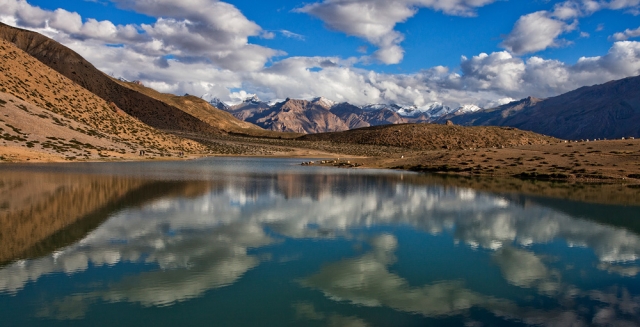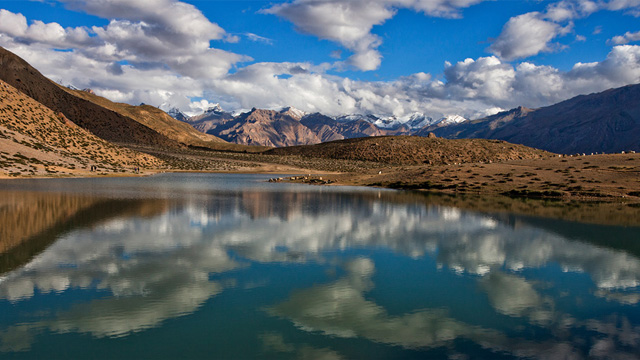A part of the remote but picturesque Lahaul-Spiti district in Himachal Pradesh, the Spiti Valley, a cold desert dotted by tiny helmets spread over the Himalayan peaks, adjoining Tibet, takes you to a land of Buddhism and virgin nature.

A century ago Rudyard Kipling in his novel “Kim” described Spiti as “a world within a world” and a “place where the god lives”. Things have hardly changed there.
A part of the remote but picturesque Lahaul-Spiti district in Himachal Pradesh, the Spiti Valley, a cold desert dotted by tiny helmets spread over the Himalayan peaks, adjoining Tibet, takes you to a land of Buddhism and virgin nature.
Kaza, the headquarters of Spiti, is some 320 km from the state capital Shimla through Kinnaur district and equidistant from the picturesque Manali tourist resort via Kunzum Pass (4,551 m).
“It’s simply a treasure trove of monasteries, where one can bring good fortunes and wash off all sins,” remarked Australian tourist Adam Scott.
Not accessible by road throughout the year, the picturesque Spiti Valley remains cut off from the world for more than four months a year due to heavy snowfall.
It reopens once the snow starts thawing after mid-April.
“This is the best period (October) to explore historic and ancient monasteries,” remarked Kaza-based tour operator Jeewan Bodh.
He said the tourists, especially the foreigners, start descending in September-end and depart with the onset of snowfall.
Lies close to Kaza is Tabo, known for a more than 1,000-year-old cave Buddhist monastery.
Founded in 996 AD, Tabo, 47 km from Kaza, is located at an altitude of 3,050 m. It’s also called the ‘Ajanta of the Himalayas’.
This is one of the largest monastic complexes in Spiti, with several caves and contemporary structures.
Perched at 3,370 m, Dhankar, 24 km from Kaza, is another repository of the ancient Buddhist culture. It was once the castle of the ruler of Spiti – the Nono.
Another centuries-old Buddhist shrine, the Key monastery, is located 12 km from Kaza and at an altitude of 4,116 m.
The monastery has rare collections of ‘thangkhas’ or Tibetan paintings and ancient musical instruments like trumpets, cymbals and drums. Its library holds the manuscripts of the Tangyur texts.
Geu, a village lies on the Indo-Tibet border, is known for a 550-year-old mummified body of a monk.
The mummy was found by a team of the Indo-Tibetan Border Police (ITBP) after an earthquake that hit the region in 1975. It was discovered from one of the eight stupas. Even the teeth, nails and hair on the skull of the mummy are intact.
For those who want to test your nerves in the rugged and inhospitable terrain, the Pin Valley National Park is the perfect challenge for you.
It’s an ideal getaway for professional trekkers as it takes one to the trans-Himalayas. It’s spread over 1,825 sq km with a core zone of 1,150 sq km.
The famous mammals in the park are the Asiatic ibex, the bharal (Himalayan blue sheep), the red fox, Tibetan wolf, stone marten, Himalayan weasel, pale weasel and the mouse hare.
The park is also home to a sizeable population of snow leopards.
The best sighting of animals can be made in November when animals start their seasonal migration to lower altitudes.
Opened to foreigners in 1992, a travel permit is a must for them.
The bumpy and uncomfortable drive from Shimla and Manali towns onwards towards Spiti is a motorist’s nightmare. The road remains closed at one place or another most of time.
So check on general road conditions and confirm whether the high mountain passes are open.
If driving in a four-wheeler, make sure you have an extra driver, especially if you plan to drive at night. Carrying extra fuel is a must.
The climatic conditions of Spiti are harsh as much of the land forms part of a cold desert where the mercury drops below minus 20 degrees Celsius during winter.
Lahaul-Spiti district, spread over 13,835 sq km, is a place of remote, untouched beauty with just 31,528 people.
The entire district has just two petrol stations – one at Tandi in the Lahaul Valley, which is around 100 km from Manali, and the second in Kaza.
The staple food is buckwheat. Barley, wheat and rice are also consumed, as well as lots of ‘chhang’ (local extracted beer) and salted tea mixed with butter.
* Getting to Kaza:
How to travel: In summer, by public or private transport. From Manali to Keylong via Kunzum; From Shimla to Rekong Peo in Kinnaur district to Spiti.
Distance: 880 km from Delhi to Manali to Keylong to Kaza; 790 km from Delhi to Shimla to Rekong Peo to Kaza.
Shimla and Manali are connected by air from Delhi.
Where to stay: Small hotels, guest houses, and even home stays with local people.
-IANS





